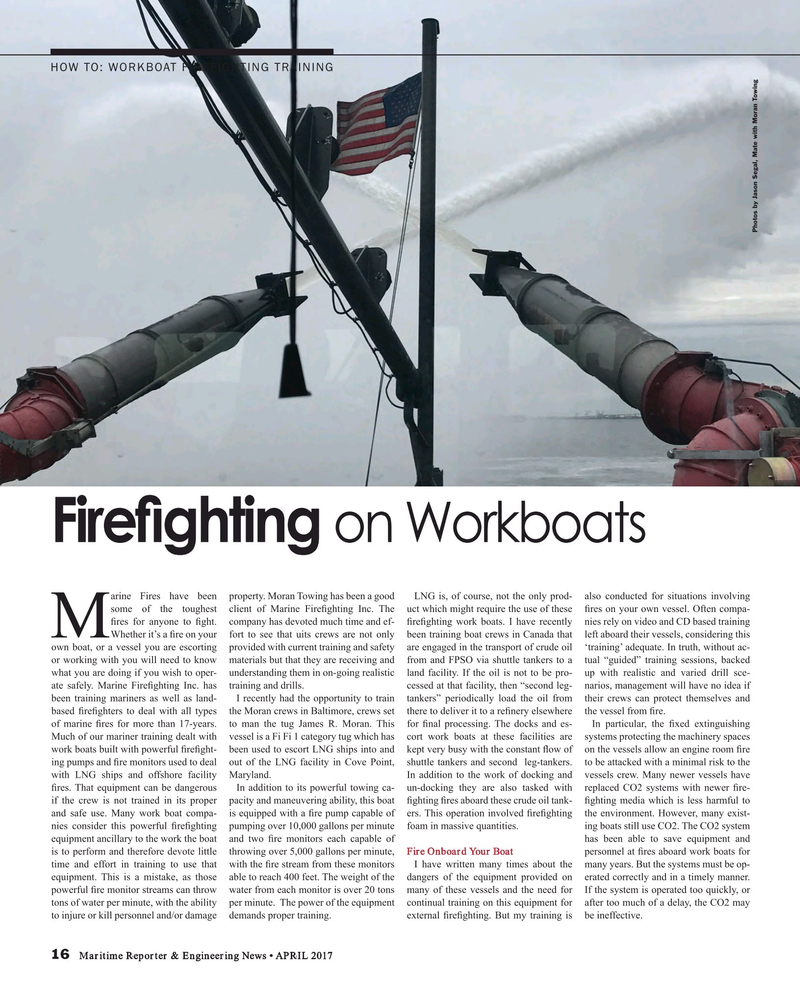
Page 16: of Maritime Reporter Magazine (April 2017)
The Offshore Annual
Read this page in Pdf, Flash or Html5 edition of April 2017 Maritime Reporter Magazine
HOW TO: WORKBOAT FIREFIGHTING TRAINING
Photos by Jason Segal, Mate with Moran Towing
Fire? ghting on Workboats arine Fires have been property. Moran Towing has been a good LNG is, of course, not the only prod- also conducted for situations involving some of the toughest client of Marine Fire? ghting Inc. The uct which might require the use of these ? res on your own vessel. Often compa- ? res for anyone to ? ght. company has devoted much time and ef- ? re? ghting work boats. I have recently nies rely on video and CD based training
MWhether it’s a ? re on your fort to see that uits crews are not only been training boat crews in Canada that left aboard their vessels, considering this own boat, or a vessel you are escorting provided with current training and safety are engaged in the transport of crude oil ‘training’ adequate. In truth, without ac- or working with you will need to know materials but that they are receiving and from and FPSO via shuttle tankers to a tual “guided” training sessions, backed what you are doing if you wish to oper- understanding them in on-going realistic land facility. If the oil is not to be pro- up with realistic and varied drill sce- ate safely. Marine Fire? ghting Inc. has training and drills. cessed at that facility, then “second leg- narios, management will have no idea if been training mariners as well as land- I recently had the opportunity to train tankers” periodically load the oil from their crews can protect themselves and based ? re? ghters to deal with all types the Moran crews in Baltimore, crews set there to deliver it to a re? nery elsewhere the vessel from ? re.
of marine ? res for more than 17-years. to man the tug James R. Moran. This for ? nal processing. The docks and es- In particular, the ? xed extinguishing
Much of our mariner training dealt with vessel is a Fi Fi 1 category tug which has cort work boats at these facilities are systems protecting the machinery spaces work boats built with powerful ? re? ght- been used to escort LNG ships into and kept very busy with the constant ? ow of on the vessels allow an engine room ? re ing pumps and ? re monitors used to deal out of the LNG facility in Cove Point, shuttle tankers and second leg-tankers. to be attacked with a minimal risk to the with LNG ships and offshore facility Maryland. In addition to the work of docking and vessels crew. Many newer vessels have ? res. That equipment can be dangerous In addition to its powerful towing ca- un-docking they are also tasked with replaced CO2 systems with newer ? re- if the crew is not trained in its proper pacity and maneuvering ability, this boat ? ghting ? res aboard these crude oil tank- ? ghting media which is less harmful to and safe use. Many work boat compa- is equipped with a ? re pump capable of ers. This operation involved ? re? ghting the environment. However, many exist- nies consider this powerful ? re? ghting pumping over 10,000 gallons per minute foam in massive quantities. ing boats still use CO2. The CO2 system equipment ancillary to the work the boat and two ? re monitors each capable of has been able to save equipment and is to perform and therefore devote little throwing over 5,000 gallons per minute, Fire Onboard Your Boat personnel at ? res aboard work boats for time and effort in training to use that with the ? re stream from these monitors I have written many times about the many years. But the systems must be op- equipment. This is a mistake, as those able to reach 400 feet. The weight of the dangers of the equipment provided on erated correctly and in a timely manner. powerful ? re monitor streams can throw water from each monitor is over 20 tons many of these vessels and the need for If the system is operated too quickly, or tons of water per minute, with the ability per minute. The power of the equipment continual training on this equipment for after too much of a delay, the CO2 may to injure or kill personnel and/or damage demands proper training. external ? re? ghting. But my training is be ineffective.
16 Maritime Reporter & Engineering News • APRIL 2017
MR #4 (10-17).indd 16 MR #4 (10-17).indd 16 4/4/2017 2:25:20 PM4/4/2017 2:25:20 PM

 15
15

 17
17
